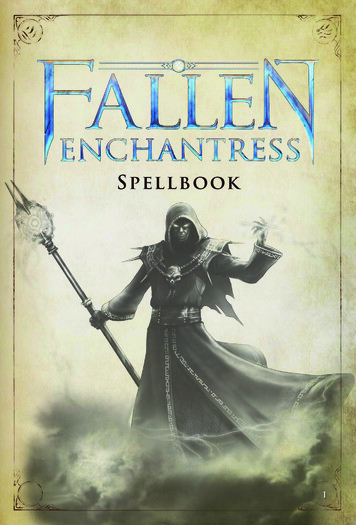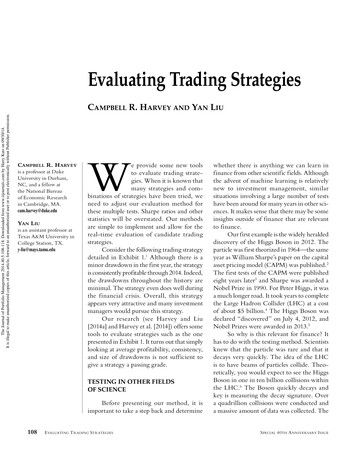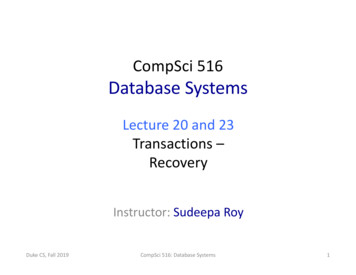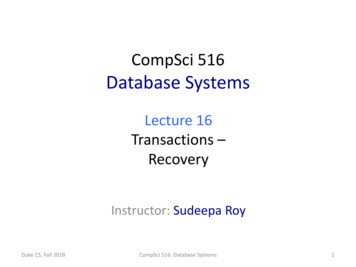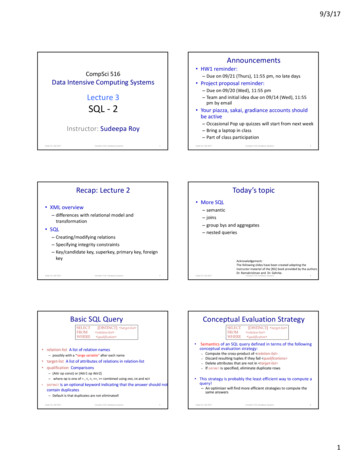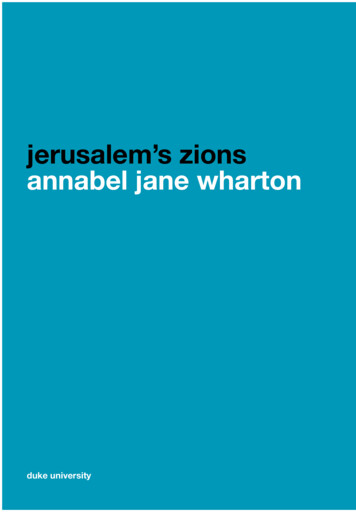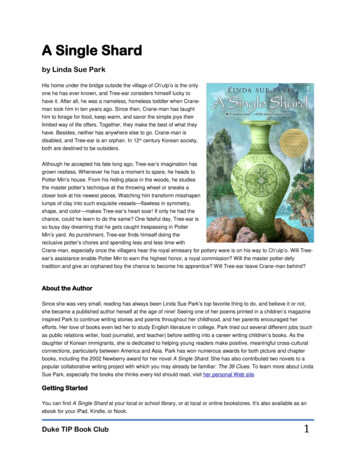
Transcription
A Single Shardby Linda Sue ParkHis home under the bridge outside the village of Ch’ulp’o is the onlyone he has ever known, and Tree-ear considers himself lucky tohave it. After all, he was a nameless, homeless toddler when Craneman took him in ten years ago. Since then, Crane-man has taughthim to forage for food, keep warm, and savor the simple joys theirlimited way of life offers. Together, they make the best of what theyhave. Besides, neither has anywhere else to go. Crane-man isdisabled, and Tree-ear is an orphan. In 12th century Korean society,both are destined to be outsiders.Although he accepted his fate long ago, Tree-ear’s imagination hasgrown restless. Whenever he has a moment to spare, he heads toPotter Min’s house. From his hiding place in the woods, he studiesthe master potter’s technique at the throwing wheel or sneaks acloser look at his newest pieces. Watching him transform misshapenlumps of clay into such exquisite vessels—flawless in symmetry,shape, and color—makes Tree-ear’s heart soar! If only he had thechance, could he learn to do the same? One fateful day, Tree-ear isso busy day dreaming that he gets caught trespassing in PotterMin’s yard. As punishment, Tree-ear finds himself doing thereclusive potter’s chores and spending less and less time withCrane-man, especially once the villagers hear the royal emissary for pottery ware is on his way to Ch’ulp’o. Will Treeear’s assistance enable Potter Min to earn the highest honor, a royal commission? Will the master potter defytradition and give an orphaned boy the chance to become his apprentice? Will Tree-ear leave Crane-man behind?About the AuthorSince she was very small, reading has always been Linda Sue Park’s top favorite thing to do, and believe it or not,she became a published author herself at the age of nine! Seeing one of her poems printed in a children’s magazineinspired Park to continue writing stories and poems throughout her childhood, and her parents encouraged herefforts. Her love of books even led her to study English literature in college. Park tried out several different jobs (suchas public relations writer, food journalist, and teacher) before settling into a career writing children’s books. As thedaughter of Korean immigrants, she is dedicated to helping young readers make positive, meaningful cross-culturalconnections, particularly between America and Asia. Park has won numerous awards for both picture and chapterbooks, including the 2002 Newberry award for her novel A Single Shard. She has also contributed two novels to apopular collaborative writing project with which you may already be familiar: The 39 Clues. To learn more about LindaSue Park, especially the books she thinks every kid should read, visit her personal Web site.Getting StartedYou can find A Single Shard at your local or school library, or at local or online bookstores. It’s also available as anebook for your iPad, Kindle, or Nook.Duke TIP Book Club1
While You’re ReadingEvery good story is full of captivating characters, timeless and timely themes, significant settings, pivotal plot points,and vivid vocabulary that combine to engage our brains and our hearts. In this section of the website, you will findactivities that invite you to dig deeper into each of these literary elements for a better understanding and enjoyment ofthe book.To aid your investigation, save our “Writing While You Read” guide (see pages 22 and 23), with helpful tips onkeeping a reading journal and annotating a book while you read.Respond to the following prompts in your Reading Journal as you read (or re-read!)Chapters 1-4 of A Single Shard: The key way a writer helps his or her readers connect with a story is through its characters. Which qualities,behaviors, and choices do you think make some characters more appealing than others? To help you answerthis question with specific evidence from the book, use the Character Grid you’ll find on pages 24 and 25 below(and you can make extra copies of page 25 if you need them). Tuck it inside your book, and, each time youmeet a new character, take a minute to jot down the name and your initial observations about him or her onyour Character Grid. Be sure to revisit your Grid every few chapters or so, too! There may be more ideas youwant to add as you get to know each character better. When we first meet Tree-ear, he has just arrived home with his pouch full of rice (5). What does his encounterwith the farmer tell you about Tree-ear’s character? What kind of boy is he? Describe Tree-ear and Crane-man’s home under the bridge. What are the prominent features, sights, sounds,textures, and smells? How do you think growing up in this setting has affected Tree-ear? Based on what you know of their situation, do you think Tree-ear and Crane-man are outsiders in Ch’ulp’o bychoice or necessity? Why? What alternatives for food, shelter, and occupation do they have? Both Tree-ear and Crane-man have unusual,nature-based names (7). How did they get thesenames? How do their names compare withothers’ in the community? In this culture, howmight one’s name be a reflection of his or herplace, or value, in society? Obviously, securing enough food is a primeconcern for Tree-ear and Crane-man on a dailybasis. They are willing to rummage for scraps inthe village rubbish heaps, eat plants that mostpeople consider “weeds” (27), and scourharvested fields for overlooked grains of rice.According to Crane-man, “these [are] honorableways to garner a meal, requiring time and work.But stealing and begging . . . [make] a man no better than a dog. Work gives a man dignity, stealing takes itaway” (6). Crane-man and Tree-ear would rather go to bed hungry than act dishonorably. How do you thinkDuke TIP Book Club2
these two characters maintain such a positive outlook despite the many challenges they face in life? Why dothey cling to their sense of honor even though they have so little? Crane-man has obviously taught Tree-ear to be mindful of proper etiquette. Tree-ear is careful to keep his eyescast downward respectfully whenever Potter Min or his wife is speaking to him (25, 30). He bows humbly whengreeting or thanking others (28, 31). He bows with palms raised when receiving a gift (34). Because he is ahomeless orphan, Tree-ear must be doubly certain that his words and behavior never cause offense,particularly to his elders. When Min catches him trespassing in his yard and accuses him of stealing, however,Tree-ear cannot resist “[raising] his head and [looking] at Min. He [keeps] his voice respectful, but his words[are] proud” (17). Much to Min’s surprise, Tree-ear stands up for himself: “I would not steal. Stealing andbegging make a man no better than a dog” (17). Why does this bold reply change Min’s mind about Tree-ear?How might this confrontation have ended differently if Tree-ear had remained silent? In what way(s) does Crane-man’s withered leg affect his day-to-day activities? What special skills and abilitieshas he cultivated despite his disability? In what way(s) is he an artist himself? Be sure to include specificexamples from the text for support.Respond to the following prompts in your Reading Journal as you read (or re-read!)Chapters 5-9 of A Single Shard: Works of historical fiction, like A Single Shard, bring people and events from the past to life and help usunderstand the human experience in a more meaningful way than textbooks can do. Based on what you haveread so far, what observations can youmake about the homes, clothing, food,religion, traditions, and customs of12th century Korea? How do thesecultural elements influence the wayTree-ear lives, thinks, and interacts withothers on a daily basis? How does Treeear’s culture compare with your owntoday? Try creating a Venn diagram(see pages 26 and 27) to help youvisualize the similarities and differences.Think about the ways in which a typicalyoung person’s life has changed overthe last nine-hundred years or so. Describe Potter Min’s creative process. Is throwing pots merely a job for him, or is it something more? How dohis completed pieces and reputation compare to other potters’ in the village? Consider how Min’s approach tohis work compares to your own. How does your own approach differ depending on whether you’ve beenassigned the work or chosen it for yourself? In some ways, it is surprising that a boy like Tree-ear would even be interested in pottery making. After all, hehas spent most of his life living under a bridge and rummaging through rubbish heaps. Nevertheless, he agreesto work for Potter Min without pay (30). He perseveres despite injuring himself many times chopping wood anddigging clay (21, 31). He withstands Min’s vague instructions, harsh mood swings, and scolding (42). To Treeear, learning to throw a pot is more than worth all of this frustration. Despite his poverty, he dreams in vividDuke TIP Book Club3
detail of the prunus vase he hopes to create someday: “It [will] be . . . the most elegant of all the shapes. Talland beautifully proportioned, rising from its base to flare gracefully and then round to the mouth” (52). Thecontrast between Tree-ear’s living conditions and his artistic vision is striking. Who or what inspires him? As thebook progresses, what gifts or abilities do you see Tree-ear discovering and cultivating in hopes that his dreamwill soon become a reality? Consider the way Potter Min supervises Tree-ear. Day after day, “[T]he potter [barks] terse commands, whichTree-ear [struggles] to satisfy by whatever means [are] available to him—watching Min, watching other potters,experimenting. He [does] not know why Min [does] not explain things more fully; Tree-ear’s mistakes often costvaluable time or [waste] valuable clay” (42). Why do you think Min doesn’t take the time to show Tree-ear whatto do? Have you ever been asked to do something without first being shown how do to it? How did that makeyou feel? Do you prefer to learn through trial-and-error, as Tree-ear must, or does another method work betterfor you? Over the course of the novel, three adults come to have a significant impact on Tree-ear’s life: Crane-man,Potter Min, and Min’s wife. Compare these adults’ treatment of Tree-ear. Does one have more of an impact onTree-ear than the others? How might having relationships with all three provide Tree-ear with a more balancedview of himself and his life? To help yourself visualize the similarities and differences in their words, tones ofvoice, body language, and attitudes, create your own triple Venn Diagram in your Reading Journal. See pages26 and 27 below for help geting started. Be sure to include specific examples from the book for support. Tree-ear observes that, though Crane-man and Potter Min are very different from one another, they do haveone quality in common: Both are very proud. In Chapter 8, Potter Min has no new inlay work to show EmissaryKim because he has broken it all in frustration over the flawed glaze and brown spots that appeared during thekiln firing (89, 85). This choice puzzles Tree-ear. Min has worked for weeks “like a man with a demon insidehim” (78). If earning a royal commission is truly “his life’s desire” (47), why doesn’t Min just show Emissary Kimone of the broken fragments? Surely his trained eye would overlook the inexplicable firing problem andrecognize Min’s impeccable skill. Later, in Chapter 9, Tree-ear is again surprised when Crane-man refusesMin’s wife’s offer to let him work for food because “[h]e does not wish to be fed out of pity” (102). Why won’tCrane-man accept her help? He knows there will be no one to bring him a daily meal for many months whileTree-ear is away.Min’s and Crane-man’s choices lead Tree-ear to wonder, “Why [is] it that pride and foolishness [are] so oftenclose companions?” (102). What do you think? What is “pride” anyway, and what makes it a valuable quality tohave? Conversely, how might one’s pride get in the way of his or her well-being? How might one avoid fallingvictim to pride? Include an example or two of your own to support your answer. At the end of Chapter 8, Min cruelly tells Tree-ear, “Know this, orphaned one . . . . If ever you learn to make apot, it will not be from me. . . . The potter’s trade goes from father to son. I had a son once. . . . He is gone now. . . You are not my son” (95). When he hears this, Tree-ear can “hardly breathe,” and, as “Min’s words [ring] inhis ears,” he “[wants] to shout” in frustration (96). After a while, though, Tree-ear calms down and comes toterms with his situation. He feels deflated but determined to continue working for Min. He even agrees to carryMin’s special pieces all the way to Songdo alone. Why do you think Tree-ear refuses to leave Min’s service?Has he given up hope that he will one day learn to be a potter? Does his pride have anything to do with it? Whatevidence in the story tells you so?Duke TIP Book Club4
Just before Tree-ear departs on his journey, he and Crane-man exchange gifts (107). In what way(s) is each gifta symbol of one friend’s deep, genuine understanding of the other? How is each friend’s offering just what theother needs?Respond to the following prompts in your reading journal as you read (or re-read!) Chapters10-13 of A Single Shard: As you probably already know from your own reading, many ancient myths and legends include magical animalcharacters. Interestingly, the fox is one such character that appears in many different contexts across manycultures. What are some stories you know in which a fox is a prominent character? What qualities or behaviorsdo you associate with the fox? How does the fox influence other characters’ choices and/or the outcome of thestory? Does the story teach a lesson or explain something about how the world works?With your answers to these questions in mind, now consider the fox’s role in A Single Shard, first when Craneman explains how he came to live under the bridge (82) and later when Tree-ear is spending the night alone inthe mountains as he journeys to Songdo (114). What role does the fox play in these two contexts? How doCrane-man’s and Tree-ear’s unusual, unexpected encounters with the fox affect them? Why do you think theauthor chose to weave this mythical animal into an otherwise down-to-earth, realistic story? Perhaps the most shocking and disheartening moment of the book occurs in Chapter 11 when Tree-ear isattacked at the Rock of the Falling Flowers. Although such brutal behavior is certainly inexcusable, sometimes itcan be helpful to try and understand what drives people to do bad things. Take a closer look at the descriptionof Tree-ear’s attackers, particularly their clothing and faces (121). Why would the bandits rob a poor,defenseless boy? How do you think the bandits must feel when they discover that, instead of food, there areonly extravagant gifts for the palace in Tree-ear’s jiggeh? At the end of Chapter 11, Tree-earresolves to put the vicious attack behindhim and take a pottery shard to Songdo.Do you think Potter Min would have donethe same in his place? Consider whatCrane-man tells Tree-ear near thebeginning of the book: “Scholars readthe great words of the world. But youand I must learn to read the world itself”(7). How has Tree-ear learned to “read”human nature in a way that Potter Minhas not? How does Tree-ear anticipateEmissary Kim will respond to thesalvaged pottery? Why? Though they show their feelings indifferent ways, Min and his wife haveclearly missed Tree-ear and worried forhis safety. When Tree-ear finally returnsfrom Songdo, Min actually sits down totalk with him and offers to teach him toDuke TIP Book Club5
throw pots. Min’s wife, who has already asked Tree-ear to call her “Ajima” (meaning “Auntie”), now urges Treeear to stay in their home permanently (91, 147). Then she asks him for a favor: “Would it be agreeable to you ifwe were to call you Hyung-pil from now on?” (147). After all this time, Min and Ajima wish to adopt Tree-ear andgive him their family name. Why is this gift so precious to Tree-ear? How will it change the course of his life? In the final chapter of the book, Tree-ear returns home only to find that his best friend, his only family, has died.At first, he feels shocked, heartbroken, and guilty for leaving Crane-man alone for so long. After some time,though, Tree-ear’s thoughts turn to the invaluable lesson he learned from his friend: “One hill, one valley . . .”(148). With that lesson in mind, Tree-ear resolves to “make replicas, dozens if need be,” until his dream ofcreating a perfect prunus vase is realized (147). How will Tree-ear’s “journey” to create this piece help him findpeace and honor the memory of his friend Crane-man at the same time (148)? Throughout ancient Asia, the crane was honored as a symbol of longevity, eternal youth, and goodfortune. Why do you think the crane was such a popular image for artists, like the one who created the real-life“Thousand Cranes Vase” (148)? What connections do you see between the crane, as a cultural symbol, andCrane-man, the character from A Single Shard? Why do you think Linda Sue Park, the book’s author,highlighted these connections in Tree-ear’s best friend and mentor? Now that you’ve finished the book, look back over the notes you’ve made on your Character Grid (see pages 24and 25), especially those about Tree-ear, Crane-man, Potter Min, and Ajima. Decide whether each of thesemain characters is static or dynamic. In what way(s) do these characters help one another overcome fear,sadness, or pain and bring out the best qualities in one another? What has changed (or stayed the same) abouteach character as a result? A Single Shard chronicles Tree-ear’s coming of age, his transition from boyhood to manhood. Looking backover the book, what would you say are the key events in Tree-ear’s growth journey? At what moment does hebegin to realize that he is no longer a child but a strong, self-reliant young man who can make decisions andlook out for himself? What evidence in the story has led you to this conclusion?For a visual, create a story map (or plot diagram) in your journal:1.2.First, draw the shape of a large mountain peak.Beginning at the bottom left of the mountain and moving up the side, record the key events in Tree-ear’s3.development. What steps does he take toward growing up?At the top of your diagram, the mountain’s peak, record Tree-ear’s turning point. At what moment does he4.finally realizes he is no longer a boy?Then, moving down the right side of the mountain, record the remaining events of the story. How do you5.see Tree-ear acting in a new, more grown-up way?Finally, consider the connections between Tree-ear’s coming of age and your own. Even though this storytakes place hundreds of years ago, what can you learn from Tree-ear about the process of growing up? Jotdown your ideas in the center of your diagram.6.Oftentimes, the title is our biggest clue to the theme, or overall message, a book’s writer wants to getacross to us readers. At first glance the title A Single Shard may remind us of the piece of fine pottery Treeear salvages from the waterfall after he is attacked. What deeper meaning might this book’s title have,though? How might you rewrite the title A Single (fill in the blank) based on a lesson you’ve learnedfrom this book? Why? Remember to explain your reasoning thoroughly and include specific evidence fromthe text for support.Duke TIP Book Club6
Getting to the RootEnglish is a living language. It changes andgrows all the time. One of the best ways tounderstand the history of the Englishlanguage and to unlock the meanings ofunfamiliar words is to learn Latin and Greekword parts. As you study biology, you willlearn more and more of these word parts, andonce you know them, you will begin torecognize them in all kinds of words—andyou'll find that your knowledge of those wordparts will help you decipher the meanings ofunfamiliar words.Roots are the "base" of plants, and Latin andGreek roots form the base of many English words. For example, the Latin root audi means “to hear.” How manymodern English words can you think of that include the root audi?Next, take a look at each word part below. Beside each part is a word from A Single Shard containing that word part.You can find the word in context on the page number in parentheses. per – perusal (4)de, ris – derision (18)im, pude – impudent (37)felic – felicitous (41)prun – prunus (52)labor – elaborate (59)1. Can you determine the meaning of the root from your knowledge of the word beside it?2. If not, think of other words that you know that also contain that root. What do those words have in common?Based on that common element, can you figure out the meaning of the root?3. If you're still stumped, check out this list of Latin and Greek roots.4. Now that you know the meaning of the root, how many words can you generate that use the root?5. Once you understand the meaning of the root, you'll find that even your understanding and appreciation offamiliar words will deepen and grow when you think about how that root works in those words.Words, Words, WordsA Single Shard is full of great words. Below is a list of some of the words from the book that may be unfamiliar to you,along with the page number on which each word appears in the story. Be sure to follow the steps below for otherwords in the book that are new to you. glean (4)oblivious (4)precariously (20)placid (22)Duke TIP Book Club7
spoor (27)insolence (30)celadon (43)diversion (51)awl (58)incision (59)connoisseur (64)surreptitiously (65)invective (66)lugubrious (72)harangued (73)pliant (75)plaintive (81)cortege (88)feigned (96)trepidation (109)studiously (112)pinioned (123)quell (134)incredulous (136)chastened (136)skepticism (138)welter (147)Before you look these words up in a dictionary—or ask someone what they mean—try working through thefollowing steps:1.Generate a list of other words that share one or more of the same word parts. What do the words on the listhave in common? Are there any clues from those commonalities that you can use to help figure out themeaning of the unknown word? Hint: Some word parts—as they appear in English words—have multiplemeanings as we look back at the Latin and Greek, in part because of changes that have occurred in the wordsover the years. For example, does the "ped-" in "pedestrian" mean the same thing as the "ped" in"pediatrician"? Where there is possible confusion, context clues (see step 2) are extremely important.2.3.Go back and reread the word in its context. This context includes the sentence in which you find the word, butyou should also read one or two sentences both before and after the appearance of the word. What contextclues do you find that might unlock the meaning of the word for you?Make your best guess at the meaning of the word.4.Look up the definition in a dictionary. Be sure to also look for information about the word's origin. Thisinformation will often contain the Latin or Greek word from which the word is derived.5.How close was your guess?Duke TIP Book Club8
ExploreOur world is full of connections—between people, places, and events. In this section of the website, you will findactivities that uncover some important connections—in chemistry, physics, history, and philosophy—between ASingle Shard and our world!ChemistryTaking a Scientific Approach to Pottery MakingUp until the last two hundred years or so, potters have been forced to rely on a time-consuming process of trial anderror to determine what combination of ingredients, glazes, and firing techniques would yield the strongest results.Surely, this approach required lots of patience and perseverance. The constant uncertainty about how pieces wouldturn out must have been very frustrating, just as it was for Min and Tree-ear in A Single Shard. Today, suchfrustrations can be avoided, thanks to recent advances in the field of chemistry. Let’s learn more about the scientifictools and techniques that help modern potters study ancient pieces, achieve more certain results, and save time,too!Activities Observe the ways in which a third-generation American potter relies on his college study of chemistry toimprove the process by which his family produces pottery. Learn how a recent college graduate combines her knowledge of chemistry, pottery making, and mathematicalmodeling to predict the outcome of different glazing techniques used in the pottery studio. Study what happens to the clay on an atomic level during the kiln firing process to make each piece of potteryhard, strong, and resistant to liquids—in other words, ideal vessels for eating, drinking, and storing foods! Whathappens to the water molecules that make clay pliable as the temperature in the kiln climbs? When the atomsrearrange themselves into a crystalline structure, what happens to the piece of pottery? Distinguish the chemical reactions, and resulting types of pottery, produced by oxidation firing versus reductionfiring. Compare the chemical make-up of ceramics (the Greek term for “pottery”) to that of other naturally occurringmaterials. Determine how the Korean Onggi potters (see the "Korean Pottery: From Everyday Use to CollectibleArt" Uncover activities on pages 11 and 12) adjust the chemical composition and firing temperature of theirclay, which results in a microporous structure that is ideal for food storage. Consider how archeological chemists collaborate with geologists, anthropologists, art historians, archeologists,and other scholars to study ancient ceramics. Using cutting-edge lab instruments, chemists canaccurately identify and date ancient pottery specimens. Imagine all the innovative ways in which ceramics science is being adapted to increase hardness and meltingpoint in existing technologies, such as car engines, hypersonic vehicles, and other high-tech devices.Duke TIP Book Club9
Did you have any idea the principles of chemistry could be applied to the study of pottery making in suchcreative, interdisciplinary, and labor-saving ways? Perhaps you might like to pursue a career in archeological orceramic chemistry. What other ways can you think of to combine your artistic and scientific interests?PhysicsMotion, Momentum, and Energy of a Potter’s WheelHave you ever thought about how and why a pottery wheel moves? What principles of physics impact the creation ofwheel-thrown pottery? Let’s take a closer look!Activities Review Sir Isaac Newton’s Laws ofMotion. Learn how the developmentof wheels and flywheels hasenabled potters to minimize frictionand conserve energy while rotatingand shaping their pottery pieces. Identify the physical force thatkeeps a potter’s work from flying offthe wheel. Why are manypeople misinformed about how andwhy this force works? Conduct an at-home experiment to see centripetal force in action!Now that you have a stronger understanding of pottery wheel movement, think about why the wheel is such animportant tool in pottery making. How do wheels make a potter’s work easier? How have potters harnessed thephysics of wheel movement to produce symmetrical pieces? Why do you think collectors often consider such piecesmore beautiful and valuable?HistoryPutting 12th-Century Korean Culture into PerspectiveMuch like beauty, history is “in the eye of the beholder.” The details of “what happened” and “why” all depend on whois telling the story! This is especially true when looking at Korean history. Because of its relatively small size andgeographical location, Korea has always had to work harder to protect its sovereignty, or independence, as a nationwhile remaining open to surrounding cultures for trade and educational opportunities. In the 12th century, whichprovides the backdrop for A Single Shard, Korean culture was heavily influenced by its relationship with China, amuch larger and more powerful nation. As a result, it can be tempting to unpack Korea’s history from a Chineseperspective. Many scholars do! Instead, let’s take our cues from the novel’s author, Linda Sue Park. In her novel,Duke TIP Book Club10
China, and other world events, are on the periphery. Their influence is felt but does not overshadow most Koreans’day-to-day effort to eke out a living. Let's consider this time period from an average Korean’s point-of-view.Activities Get a sense of what was happening elsewhere around the world during the 12th century, which is part of thePost Classical Era of human history. How does the Korean way of life depicted in A Single Shard compare withothers around the world in the same time period? What was happening politically and socially in Asia, Europe,the Middle East, and the Americas? How much do you think people from small Korean villages—like Potter Min,Tree-ear, and Crane-man—would know of, or be affected by, these world events and cultural differences? Narrow in on the accomplishments of the Chinese Song Dynasty and consider the strong influence it must havehad on neighboring Korea. Notice that Korea is even included within Chinese boundaries on this historical map.Whose historical point of view do you think the map represents? Why? Consider what makes the Korean perspective on Post-Classical history, trade, technology, art (be sure to clickon each piece of art to learn how it was influenced and created!), and religion distinct from China’s.Throughout its history, Korea has withstood many attacks from countries who wanted to take over its lands andresources for their own political and economic gain. The political pressures of the 20thcentury were particularly strong,and, as a result, Korea split into two nations, North and South Korea, in 1945 at the end of World War II. Relationsbetween the two nations have been tense ever since. Despite these difficulties, Koreans remain resilient andcommitted to collaborating with other nations to improve their homeland. Many are also hopeful that North and SouthKorea will someday overcom
Duke TIP Book Club. 4 . detail of the prunus vase he hopes to create someday: “It [will] be . . . the most elegant of all the shapes. Tall and beautifully proportioned, rising from its base to flare gracefully and then round to the mouth” (52). The contrast between Tree-ear’s living
